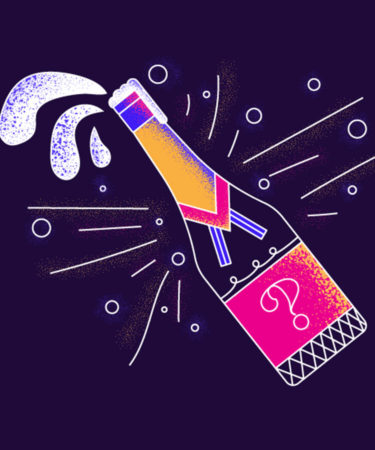With its lofty price tag and explosive cork, we’d probably all rather drink Champagne than buy or serve it. Speak to wine industry professionals, however, and they’ll tell you that drinkers should not be intimidated by the sparkling wine. In many ways, they’ll say, it’s just like any other wine, and not deserving of its reputation as a “holidays-only” drink.
To help make the extra-special sparkler a bit more approachable, here are 10 questions you’re too afraid to ask about Champagne, answered.
Can all sparkling wine be called Champagne?
Only wines made within a specific northeastern French region can use the labeling term Champagne. Geographical boundaries aren’t the only thing that defines the wine, though; the region also enforces strict appellation laws. Grape-growing and winemaking practices are closely controlled, affecting everything from the grape varieties used, to vineyard and press yields, and the methods by which the wine gains its bubbles.
How does Champagne become bubbly?
When you’re making Champagne, secondary fermentation, the process that adds bubbles to wine, must take place in bottle. Known as the méthode Champenoise (Champagne method) or méthode traditionnel (traditional method), the process requires that winemakers start fermentation after they add a mixture of yeast, wine, and sugar, called liqueur de tirage, to the still base wine. The process releases carbon dioxide, making the wine bubbly. When fermentation ends, yeasts die and become lees, remaining in contact with the wine until they’re later removed by the winemaker.
Is Champagne made with white grapes?
Champagne winemakers can use seven varieties in their blends. The list includes white grapes Chardonnay, Petite Arbanne, Petit Meslier, Pinot Blanc, and Fromenteau, as well as red grapes Pinot Noir and Pinot Meunier.
Most commonly, Champagne blends include a combination of Pinot Noir, Chardonnay, and Pinot Meunier, though other examples abound. Wines made exclusively with white grapes are called blanc de blancs, and less-common blanc de noirs contain only red grapes.
Why don’t all Champagnes list a vintage on the bottle?
Non-vintage (NV) Champagnes are the most common (and affordable) style of the wine. Producers use grapes and grape must from multiple vintages to create a specific flavor profile, or “house style.” The process helps maintain consistency from year to year.
Vintage Champagnes contain grapes from just one harvest. Like standard wine bottles, the vintage denotes the year of harvest. Vintage Champagnes appear only in the best years, which are selected by the Champagne house’s chef de cave, or cellar master.
Why does Champagne smell like bread?
The wine’s contact with lees adds texture, richness, and complexity, including yeasty aromas and flavors. Appellation laws dictate the duration of time Champagne stays in contact with lees, or sur lie. Non-vintage bottles must remain sur lie for a minimum of 12 months, and vintage Champagne requires three years. In practice, most Champagnes age for much longer, with an average of two to three years for non-vintage wines and four to 10 years for vintage Champagne.
Is all Champagne dry?
Sugar is a vital ingredient in Champagne production and can be added a total of three times during the winemaking process. The first addition helps raise the alcohol level during primary fermentation if grapes don’t achieve enough ripeness in the vineyard. The next starts the secondary, bubble-adding fermentation. The third time sugar is added, called the dosage, determines the sweetness of the wine.
Champagne’s sweetness ranges from bone-dry brut nature, which contains less than three grams per liter (g/l) of residual sugar, to sweet doux, which contains upwards of 50 g/l.
What’s the correct way to open a bottle of Champagne?
The average bottle of Champagne is bottled with a pressure of five to six atmospheres. That’s approximately double the pressure in your car’s tires. A few key tips can help release the cork safely, and without losing precious wine.
After removing the bottle’s foil and wire cage, keep a thumb firmly-pressed on top of the cork, and slowly twist the base of the bottle. The cork will loosen gradually until it’s finally released, emitting a soft hiss or faint pop. If the cork or your hand contain moisture from bottle condensation, use a clean, dry dishcloth to help keep a steady grip. Chilling the bottle also helps avoid any buildup of extra pressure.
Alternatively, you can go big, and saber the bottle to impress your friends. This is less dangerous than it looks, but does involve glass and a sharp knife. Please practice carefully before attempting this at home.
What’s the secret to keeping an open bottle of Champagne bubbly?
When not serving Champagne, keep the open bottle sealed to prolong its effervescence. A high-quality Champagne stopper is essential for this, and a well-sealed, refrigerated bottle of wine will keep its bubbles for three to five days.
Does Champagne pair well with food?
Yes. It’s delicious with canapes as an aperitif, and surprisingly versatile when it comes to meal pairing. The wine’s high acidity cuts through rich foods, and its savory, yeasty character balances sweetness. A crisp, refreshing finish leaves the palate feeling clean.
Champagne can also provide an excellent high-low pairing, as it works particularly well with dishes like fried chicken and pizza.
What’s the best glass to serve Champagne in?
The Champagne flute is the traditional serving vessel. Its tall, skinny form preserves the sparkling wine’s bubbles.
But by no means is it the only glass for serving Champagne. A quality white wine glass helps pronounce Champagne’s intense aromas, and is preferred by many industry professionals for that reason. The tulip is a tall, but wide-bodied, happy medium.
If you want to invoke the spirit of Jay Gatsby, you can also turn to Champagne coupes, which look great, though offer less in the way of improving the drinking experience.
